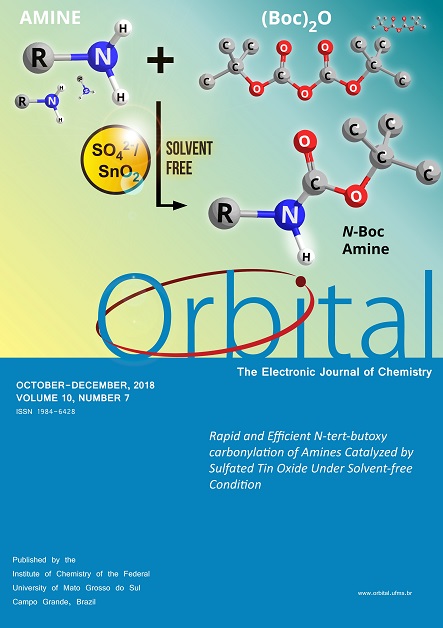Flame Atomic Absorption Determination of Cd and Cu in Biological Samples After Solid Phase Extraction by Octadecyl Silica Membrane Disks Modified With a Schiff Base Ligand
- copper,
- cadmium,
- solid phase extraction,
- octadecyl silica,
- Schiff base
- atomic absorption spectrometry ...More
Copyright (c) 2018 Orbital: The Electronic Journal of Chemistry

This work is licensed under a Creative Commons Attribution-NonCommercial-NoDerivatives 4.0 International License.
Abstract
A procedure for separation and preconcentration of trace amounts of Cu2+ and Cd2+ from aqueous media is proposed. The procedure is based on the adsorption of Cu2+ and Cd2+ ions on octadecyl bonded silica membrane disk modified with, Pyridine 2,6-diylbis{2,2’(azamethane-1-ylidene)4-bromophenol} (L) at pH = 8. The ligand has been synthesized by reaction of the 2,6-diamino pyridine and 5-bromo salicylaldehyde at ethanol under refluxing. The structure of the synthesized compound resulted from the Fourier-transform infrared spectroscopy (FTIR), Proton nuclear magnetic resonance (1H NMR), Mass spectrometry (MS) and UV spectroscopy and elemental analysis data. The solid phase extraction experimental conditions were optimized by changing several parameters such as volume of eluting solvent, the effect of pH, limit of detection and maximum capacity of the disks for Cu2+ and Cd2+ recovery. The retained Cu2+ and Cd2+ ions were then stripped from the disk with a minimal amount of 0.7 mol.L-1 nitric acid and 1 mol.L-1 hydrochloric acid solution as eluent respectively, and determined by flame atomic absorption spectrometry. The limit of detection of the proposed method was 7.6 and 3.6 ng.mL-1for copper and cadmium ions, respectively. The method was successfully applied to determination of copper and cadmium in natural biological samples and the method was quantitative.


